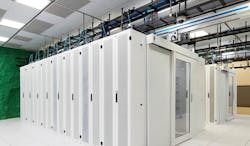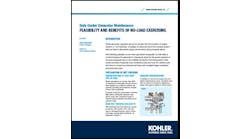In this week’s Voices of the Industry, Mark W. Jobson, Director of Product Marketing for Iron Mountain’s data center business unit, discusses 2018 data center and colocation projections, and what the next year may hold for the two industries.
Mark W. Jobson, Director of Product Marketing for Iron Mountain’s data center business unit
Having just returned from a major analyst/industry trade show, I’m reminded of how technologists love to prognosticate the incredible to brand ourselves as innovators. In light of this perspective, I will keep my 2018 projections for the data center industry in the realm of the realistic, with a few out-of-the-box topics added for flavor.
Northern Virginia will dominate the industry headlines once again as hyperscale cloud providers like Amazon Web Services and Google, colo providers and other wholesale data center buyers like Facebook execute on aggressive growth plans for the region.[1] [2] It appears 2018 will be yet another big one for the world’s largest data center market even with the cost per acre exceeding $1.2M. [3]
Dallas and Phoenix will also ride the wave of cloud deals, positive economic trends, favorable business/data center environments, and population influx. JLL had Dallas as the second largest data center market in terms of absorption through the first half of 2017, with 41.5 Megawatts up from 36 Megawatts in 2016. Phoenix ended 2016 with 16.3 Megawatts of absorption according to JLL with 70 MW of demand/35 MW’s of absorption projected for 2017.[4]
The data center industry may continue to see market consolidation with M&A activity from providers looking to scale or prevent competitors from scaling. Intense competition for available colocation provider books should lead to strong multiples for sellers. According to CBRE, 2017 was a record-breaking year for data center investment, surpassing the previous three-year-combined total.[5]
Multi-cloud management and cloud segmentation may create new opportunities for hyperscale and emerging cloud players alike as IT departments get more scientific with their cloud architecture/deployments. According to a press release issued by analyst firm Markets and Markets, the Multi-Cloud Management Market is expected to grow at a 30.9% CAGR, moving from $1,169.5M in 2017 to $4,492.7M by 2022.[6]
Federal agencies will continue to move towards the DCOI/consolidation goals set for the end of 2018. However, with executive office de-prioritization of renewable energy / energy efficiency, progress may slow. The government watchdog Government Accountability Office projects 17 of 24 participating agencies will fail to be DCOI compliant by the end of 2018.[7]
2018 could see increased focus and investment by colo providers and large data center operators in renewable energy. Thanks to efforts from leaders like Iron Mountain and Digital Realty Trust, renewable energy is no longer an offering only for those organizations willing to pay a premium in exchange for their environmental responsibility.
In 2017, multiple wind farm deals made headlines (Pennsylvania’s Ringer Hill, Amazon Wind Farm in Texas). Each of these underscored how renewable power could be used to hedge against price volatility and offered to customers at a cost-competitive price.
This is good for the industry, the business, customers, and the environment. Green power offerings may lead to more data center companies / large-scale operators dipping their toes in the renewable energy market in 2018.
In 2018, colo providers will try their best to innovate to integrate with customers’ cloud environments and delivery models.
To meet the needs of its customers, colocation providers may adjust/augment their offering to integrate with a more cloud-like use case. Think on-demand services, better portal integration/user experience and services to match the temporary/seasonal cloud use cases.
[clickToTweet tweet=”Mark Jobson – ‘The 2018 data center industry may continue to see market consolidation.'” quote=”Mark Jobson – ‘The 2018 data center industry may continue to see market consolidation.'”]
Additionally, colocation providers may look to augment cloud/services provider connectivity options to help customers establish a centralized, efficient customer hybrid IT data center hub, good for providers like MegaPort. Again referencing Markets and Markets, the software-defined networking (SDN) market is projected to grow from $2.46B in 2016 to $54.41B in 2022.[8]
In 2018, the “60%’ers” may finally go colo.
Based on analyst data, it feels like we have faced a 60/30/10 split – in-house / colocation / IT services provider – for a few years now. However, according to RightScale’s State of the Cloud report for 2017[9], 95 percent of businesses are using cloud of some kind and 67% of the total respondents are using hybrid IT. Additionally, non-IT departments are leveraging six to seven different cloud services to accomplish their day-to-day roles. With the rise of multi-cloud management platforms making multi-cloud easier, safer and more efficient than ever before, the so-called “60%’ers” might just surprise us.
Multi-cloud means app/data segmentation and inter-cloud orchestration. More net-new hardware leaving the in-house rack and going cloud. The success of hyperconverged infrastructure further reduces the number of boxes and blinking lights at the legacy, in-house data center, but still maxes out available power. Then, there is the difficulty of getting desirable network and cloud access options at the in-house data center/office building slowing growth and performance while increasing complexity and cost.
If the 60%’ers say goodbye to applications and data sailing off to far away cloud infrastructure, owned by someone else, does this mean they are warming to the idea of the outsourced data center? Will they see their legacy data center/s in a different light?
The 60%’ers can opt to put the hardware / apps not headed for a cloud in colocation facilities, reducing their data center costs and making hybrid IT integration easy, secure and scalable.
In 2018, IT budgets may go up, but not by as much as we might want. Still, it could mean more dollars for the data center.
The Iron Mountain VA-1 data center, which opened in September at the company’s new campus in Manassas, Va. (Photo: Rich Miller)
I was pleased to see in the 2018 Spiceworks State of IT report that IT budgets are projected to increase next year. Upwards of 44 percent reported their budgets were going up, with the average increase for that group coming in at 19 percent![10] Not too shabby. The same survey cited only 10 percent of respondents said they were losing budget in 2018.
However, after polling an enterprise IT audience at a recent speaking engagement and having anecdotal conversations with IT executives in my network, only a handful are seeing 20% increases. Instead, the more frequent response is, “Yes, we will probably get more budget, but not that much more.”
Still, more budget is more budget. So what will tech orgs do with the newly found funds? As you would expect, hardware purchases, staffing increases and licensing are amongst the percentage leaders. The good news for data center fans is that the State of IT report cites hosting and cloud environments as the fastest growing of the top-five budget segments.
Support Science-Technology-Engineering-Math Initiatives in 2018
Keeping with the State of IT report, 45 percent said they would be hiring new IT staff to address gaps with their increased IT budget. However, what happens if there are no qualified candidates to hire?
According to Dice.com, the national IT unemployment rate was 2.5 percent in Q1 2017.[11] This is almost half of the national unemployment rate with some states reporting IT unemployment rates as low as 1.6 percent.[12]
Couple the small talent pool with reported average salary for tech-sector workers at $108,900 – more than double the 2016 national average of $53,040 – and you get a hiring problem for IT executives, even with pockets flush with cash.[13]
As a result, I believe this will lead to even more investment in high school, college, and even adult-level STEM initiatives as professionals change paths in pursuit of higher wages. For now, IT organizations must rely on cross training or outsourcing if talent is not available.
The tech sector will not be slowing down any time soon. In 2016, 10 percent of all new jobs added to the economy were tech jobs. U.S. tech businesses grew for the fifth consecutive year to 492,550 in 2016 with Texas alone adding nearly 1,000 new tech businesses. The tech sector accounts for 8 percent of total activity in the US economy, or $1.3 trillion.[14] In order to facilitate this incredible growth, onshore IT talent must be cultivated.
Change management will be the theme of 2018, and it should be a wild ride.
With new money to fuel hybrid IT and multi-cloud management initiatives, testing of new technology and IoT integration, hiring new team members, and outsourcing, IT departments may be able to accomplish more in 2018 than in recent years.
I for one am excited to see where we are at this point next year. Will increased resources make 2018 the year we finally solve the backup and disaster recovery challenge? Will the increased positive momentum of Women in IT programs diversify the data center industry workforce?
All of this adds up to a whole lot of change in a short amount of time with added layers of hyper-complexity and risk to boot. That is why I believe the top challenge this year for IT executives will be change management in a hybrid IT world. Without the budget fallback, will IT organizations scale to meet their challenges?
One thing is for sure, there will be plenty of work to go around. Thank you in advance to all of the technologists who will put in the blood, sweat and tears to accomplish great things in 2018.
Mark W. Jobson, is director of product marketing for Iron Mountain’s data center business unit.
[1] Datacenterfrontier.com – “Google Buys Two Data Center Sites in Northern Virginia” – 11/29/2017 – Rich Miller
[2] Datacenterfrontier.com – “Amazon Plans Epic Data Center Expansion in Northern Virginia” – 11/6/2017, Rich Miller
[3] Datacenterfrontier.com – “CloudBoom: Leasing, Land Deals Surge in Northern Virginia – 10/31/17 – Rich Miller
[4] JLL – “2017 Data Center Outlook – North America”
[5] Datacenterknowledge.com – “Data center Investment in the US This Year Already Beats All Records” – 9/29/17 –
[6] MarketsandMarkets Research – “Multi-Cloud Management Market Worth 4,492.7 Million USD by 2022”
[7] Datacenterknowledge.com – “After Decade of Data Center Consolidation, US States Report Mixed Success – 11/30/17, Wylie Wong
[8] MarketsandMarkets – “Multi-Cloud Management Market worth 4,492.7 Million USD by 2022”
[9] RightScale – “State of the Cloud Report 2017”
[10] Spiceworks – “2018 State of IT Report”
[11] Dice.com – “Tech’s Unemployment Rate Held Level in Q1” – May 2, 2017
[12] Upp.com – “IT Unemployment Rates”
[13] CompTIA – “US TECH SECTOR EMPLOYMENT APPROACHES 7 MILLION” – April 3, 2017
[14] CompTIA – “US TECH SECTOR EMPLOYMENT APPROACHES 7 MILLION” – April 3, 2017





